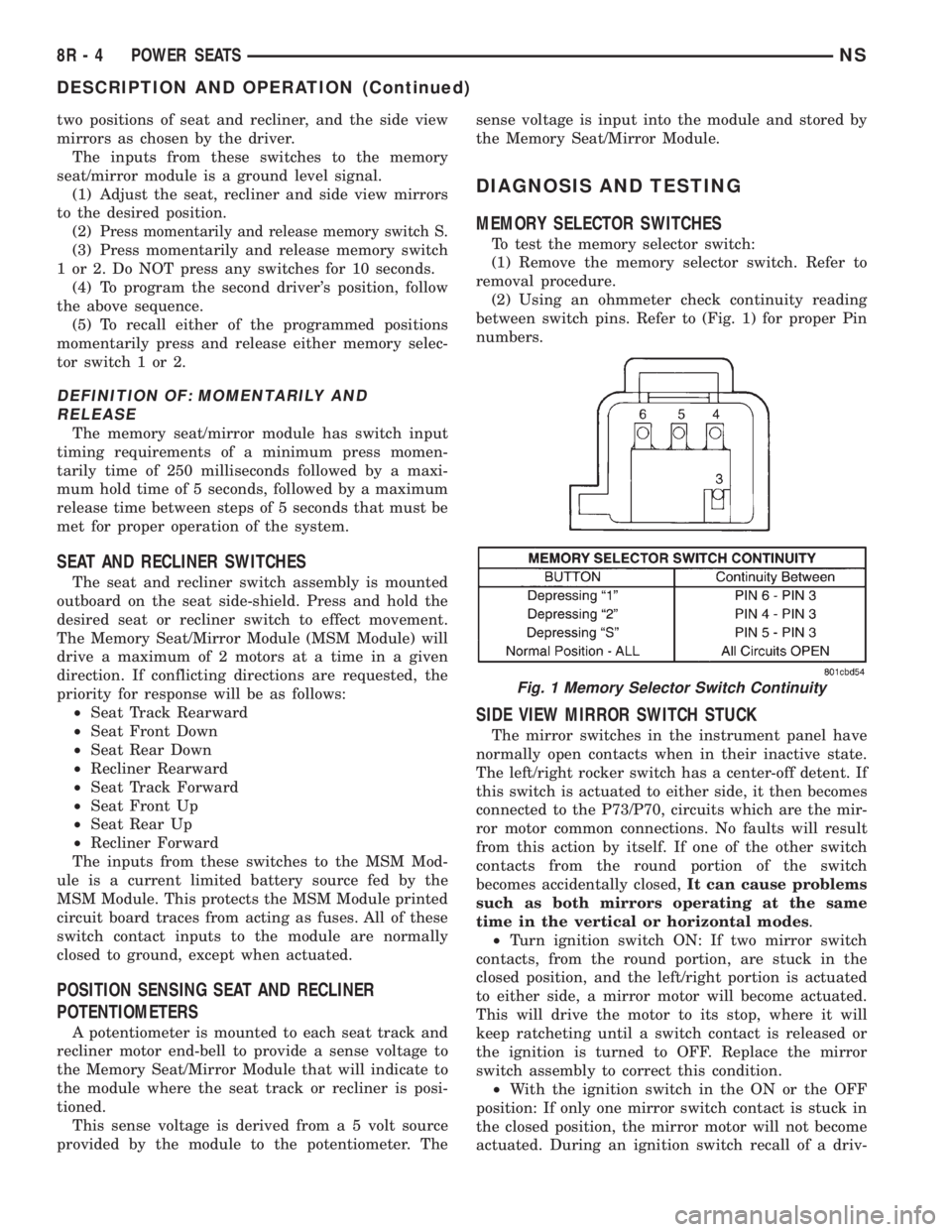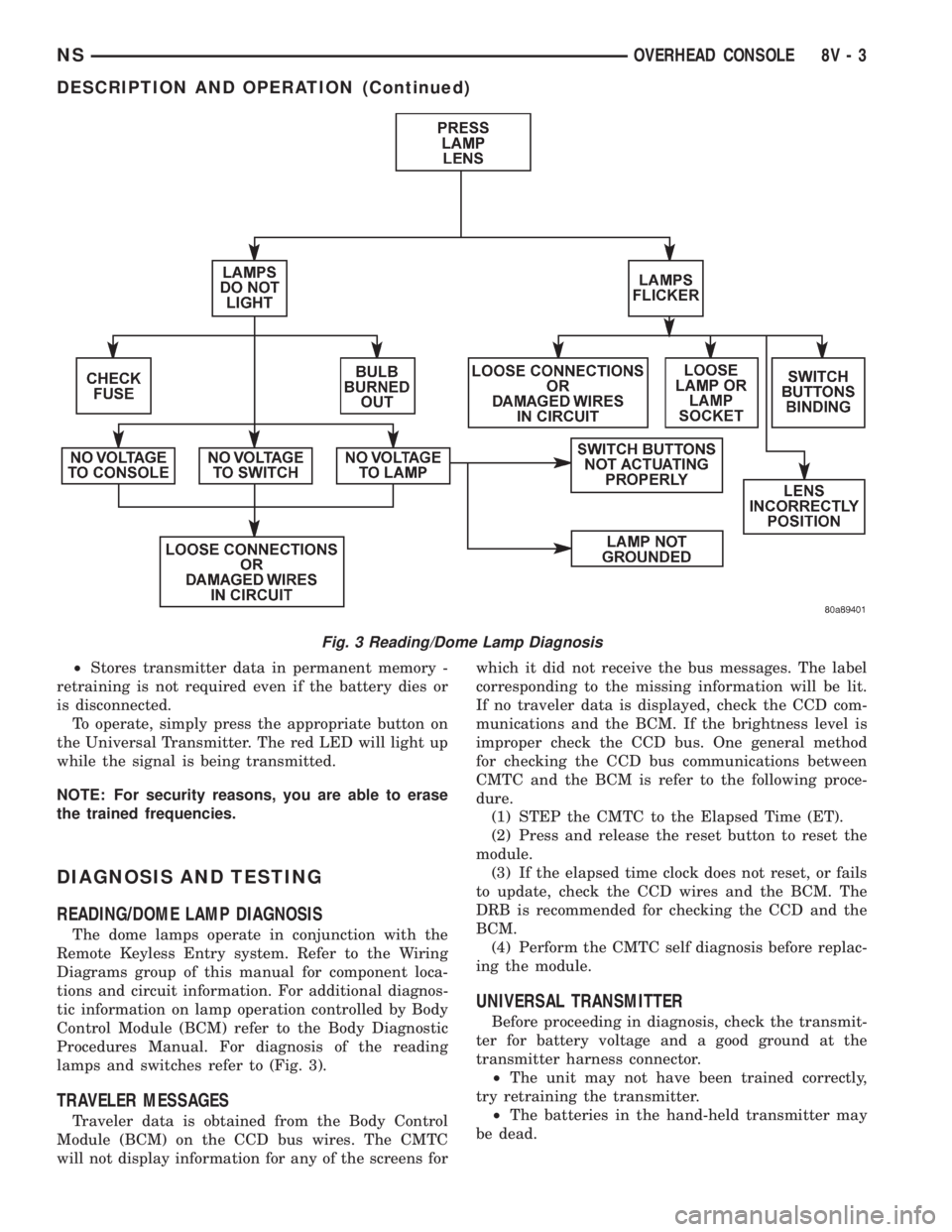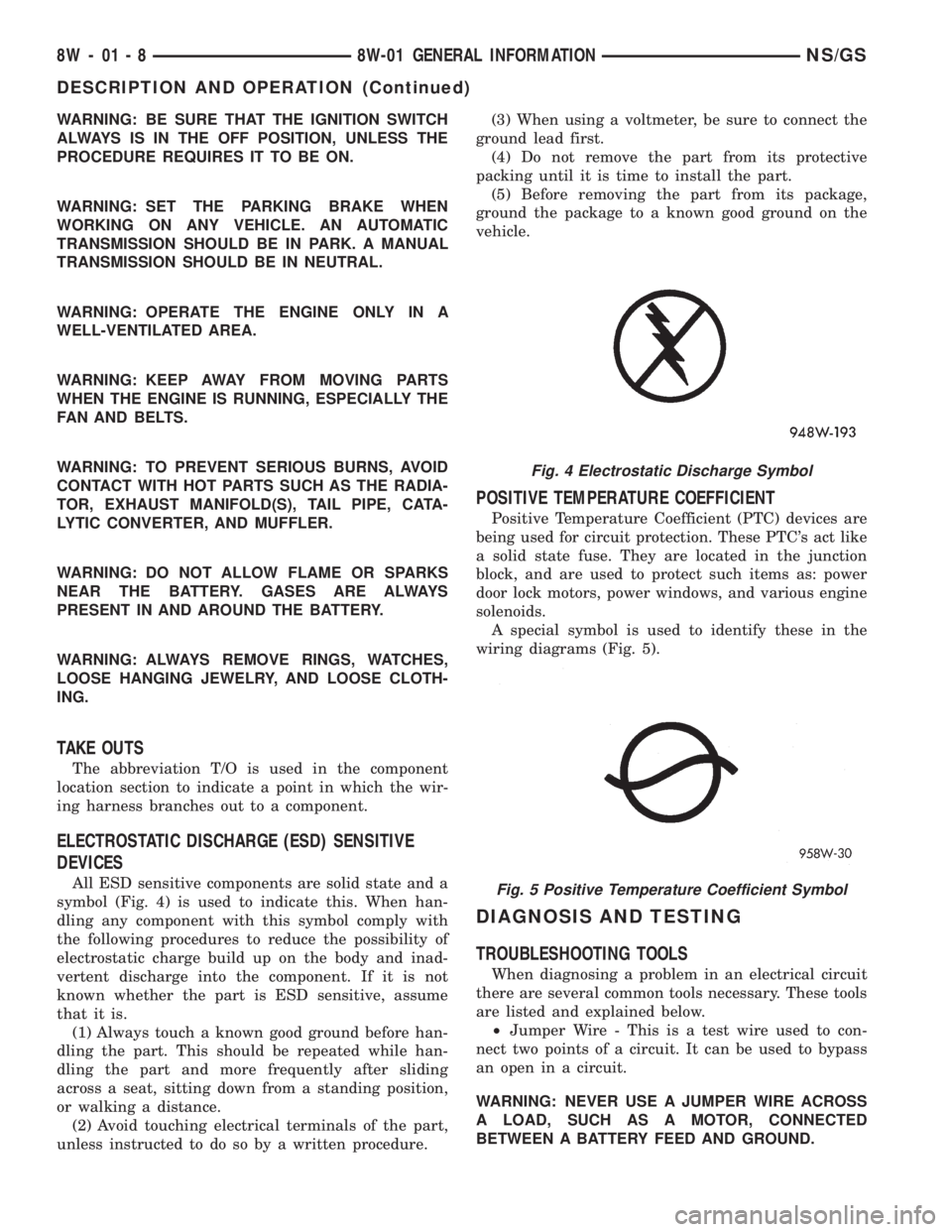ESP CHRYSLER VOYAGER 1996 Owner's Manual
[x] Cancel search | Manufacturer: CHRYSLER, Model Year: 1996, Model line: VOYAGER, Model: CHRYSLER VOYAGER 1996Pages: 1938, PDF Size: 55.84 MB
Page 532 of 1938

two positions of seat and recliner, and the side view
mirrors as chosen by the driver.
The inputs from these switches to the memory
seat/mirror module is a ground level signal.
(1) Adjust the seat, recliner and side view mirrors
to the desired position.
(2)
Press momentarily and release memory switch S.
(3) Press momentarily and release memory switch
1 or 2. Do NOT press any switches for 10 seconds.
(4) To program the second driver's position, follow
the above sequence.
(5) To recall either of the programmed positions
momentarily press and release either memory selec-
tor switch 1 or 2.
DEFINITION OF: MOMENTARILY AND
RELEASE
The memory seat/mirror module has switch input
timing requirements of a minimum press momen-
tarily time of 250 milliseconds followed by a maxi-
mum hold time of 5 seconds, followed by a maximum
release time between steps of 5 seconds that must be
met for proper operation of the system.
SEAT AND RECLINER SWITCHES
The seat and recliner switch assembly is mounted
outboard on the seat side-shield. Press and hold the
desired seat or recliner switch to effect movement.
The Memory Seat/Mirror Module (MSM Module) will
drive a maximum of 2 motors at a time in a given
direction. If conflicting directions are requested, the
priority for response will be as follows:
²Seat Track Rearward
²Seat Front Down
²Seat Rear Down
²Recliner Rearward
²Seat Track Forward
²Seat Front Up
²Seat Rear Up
²Recliner Forward
The inputs from these switches to the MSM Mod-
ule is a current limited battery source fed by the
MSM Module. This protects the MSM Module printed
circuit board traces from acting as fuses. All of these
switch contact inputs to the module are normally
closed to ground, except when actuated.
POSITION SENSING SEAT AND RECLINER
POTENTIOMETERS
A potentiometer is mounted to each seat track and
recliner motor end-bell to provide a sense voltage to
the Memory Seat/Mirror Module that will indicate to
the module where the seat track or recliner is posi-
tioned.
This sense voltage is derived from a 5 volt source
provided by the module to the potentiometer. Thesense voltage is input into the module and stored by
the Memory Seat/Mirror Module.
DIAGNOSIS AND TESTING
MEMORY SELECTOR SWITCHES
To test the memory selector switch:
(1) Remove the memory selector switch. Refer to
removal procedure.
(2) Using an ohmmeter check continuity reading
between switch pins. Refer to (Fig. 1) for proper Pin
numbers.
SIDE VIEW MIRROR SWITCH STUCK
The mirror switches in the instrument panel have
normally open contacts when in their inactive state.
The left/right rocker switch has a center-off detent. If
this switch is actuated to either side, it then becomes
connected to the P73/P70, circuits which are the mir-
ror motor common connections. No faults will result
from this action by itself. If one of the other switch
contacts from the round portion of the switch
becomes accidentally closed,It can cause problems
such as both mirrors operating at the same
time in the vertical or horizontal modes.
²Turn ignition switch ON: If two mirror switch
contacts, from the round portion, are stuck in the
closed position, and the left/right portion is actuated
to either side, a mirror motor will become actuated.
This will drive the motor to its stop, where it will
keep ratcheting until a switch contact is released or
the ignition is turned to OFF. Replace the mirror
switch assembly to correct this condition.
²With the ignition switch in the ON or the OFF
position: If only one mirror switch contact is stuck in
the closed position, the mirror motor will not become
actuated. During an ignition switch recall of a driv-
Fig. 1 Memory Selector Switch Continuity
8R - 4 POWER SEATSNS
DESCRIPTION AND OPERATION (Continued)
Page 534 of 1938

ACTIVATION-Press and hold the S and 1 buttons
for 5 seconds to enter diagnostic mode 1. This mode
is exited at the completion of the mode 1 tasks or
upon grounding the RKE input to the Memory Seat/
Mirror Module.
Mode 1 will:
²Clear all soft limits to their default hard limit
values
²Load memory 1 with default settings corre-
sponding to horizontal rearward, front down, rear
down, and recliner rearward positions²Load memory 2 with default settings corre-
sponding to horizontal forward, front up, rear up,
and recliner forward positions
MODE 2
Diagnostic mode 2 provides a way to determine if
the seat/mirror motors and position sensors are con-
nected properly.
ACTIVATION-Press and hold the S and 2 buttons
for 5 seconds to enter diagnostic mode 2. This mode
is exited after 5 seconds of switch inactivity or upon
grounding the RKE input by moving the transmis-
sion out of the PARK position.
Mode 2 will:
²Place the seat and mirror motors at their mid-
point
²When a single axis of seat or mirror motion is
requested by pressing a switch, the corresponding
motor is energized. This tests switch input and motor
output
²When the switch is released, the motor will
automatically return to its original position. If the
corresponding sensor is out of range, then the motor
will not return to its original position. This tests the
integrity of the sensors and motor outputs. Refer to
(Fig. 3), (Fig. 4), (Fig. 5) and (Fig. 6) for module con-
nector call outs.
Fig. 3 Memory Seat/Mirror Module
Fig. 4 Memory Seat/Mirror Module 10-Way Connector
8R - 6 POWER SEATSNS
DIAGNOSIS AND TESTING (Continued)
Page 536 of 1938

nector (cavity 5)This is a low current battery
feed from the control module that will not illu-
minate a test lamp.
During shipping of the vehicle, an M1 circuit 10
amp fuse (labeled IOD) is temporarily removed from
the PDC in the engine compartment to eliminate
unnecessary battery depletion. However, this fused
circuit being open (that feeds through the electrical
distribution wiring to cavity 16 of the 25-way connec-
tor) will not stop manual seat actuations from taking
place (only recall mode requests) during shipping.
(1) If the memory seat/mirror module does not
respond with a relay click to any seat switch input
(as well as the desired motion) when actuated, pro-
ceed with the following analysis:²Verify power ON F35 and ground Z1 into the
system as indicated above.
²Verify all connectors are mated with the memory
seat/mirror module.
²Place the vehicle gear shift lever in any position
except PARK (causes the Memory Seat/Mirror Mod-
ule to wake-up and provide a position sense voltage
to the seat motor potentiometers and the mirror
rheostat(s). This voltage can be checked at the appro-
priate cavities of the 21 and 25-way connectors.
²Verify the switch connector is mated with the
seat switch on the inside of the outboard side-shield.
²Verify battery voltage at the P9 circuit refer-
enced to the Z1A ground reference (cavity 1) of the
seat switch. If P9 low current battery is not available
Fig. 6 Memory Seat/Mirror Module 25-Way Connector
8R - 8 POWER SEATSNS
DIAGNOSIS AND TESTING (Continued)
Page 537 of 1938

coming from the module, replace the Memory Seat/
Mirror Module.
²If P9 low current battery is present at (cavity 5)
referenced to ground Z1 (cavity 1) of the seat switch,
verify the presence of the P9 voltage at the switch
outputs. If there is no output voltage from the
switch, replace the switch.
²If P9 voltage is present at the output of the
switch, but there is no reaction from the memory
seat/mirror module, verify that the P9 voltage is
present at the appropriate 21-way connector pins
into the module. If the P9 voltage is not present at
the 21-way connector, repair or replace the seat wir-
ing harness. If the verification check of the seat wir-
ing harness is correct, replace the control module.
(2) If the control module does not respond with a
relay click to a specific seat switch when actuated,
verify the continuity of the particular circuit between
the seat switch and the Memory Seat/Mirror Module.
If the P9 voltage is present at the correct input of the
21-way connector of the module when the switch is
actuated, but there is no response by the module,
replace the Memory Seat/Mirror Module.
(3) If the Memory Seat/Mirror Module responds
with a relay click when a seat switch is actuated for
a given direction, but there is no reaction from a seat
or recliner motor relating to that switch input, dis-
connect the 10-way connector from the control mod-
ule. Jumper the battery and ground from cavities 8
and 7 of the seat harness 10-way connector to the
proper cavities for the seat or recliner motor in ques-
tion and direction of travel desired. If the motor oper-
ates, replace the control module. If the motor does
not operate, verify continuity of the wiring into the
motor 2-way connector. Repair or replace the wiring
as necessary. If the wiring has continuity, and the
motor will not operate when fed directly, replace the
track assembly, since the motor/transmission combi-
nations are not designed to be serviced on an individ-
ual basis.
SEAT AND RECLINER POSITION SENSING
Seat and recliner position sense ground reference
circuit P28 BR/RD feed is from the memory seat/mir-
ror module (cavity 10) 21-way connector to each of
the position sense connectors.
Seat and recliner position sense +5 volt feed circuit
P29 BR/WT feed is from the memory seat/mirror
module (cavity 20) 21-way connector to each of the
position sense connectors.
To test for the presence of a sense voltage, a volt
meter must be used as follows:
²Connect the negative probe to the P28 circuit
(cavity 10) of the 21-way connector.
²Connect the positive probe to the P29 circuit
(cavity 20) of the 21-way connector and verify a volt-age reading between 3.5 and 5 volts when a seat or
recliner switch is activated.An internal timer in
the Memory Seat/Mirror Module (MSM Module)
regulates the length of time this voltage stays
active i.e., 3 seconds from the time that the
switch was activated, unless the switch is held
or while the transmission is out of PARK.If the
voltage is less than 3.5, there is a fault in the system
that is drawing it down. To troubleshoot this circuit,
disconnect the 25-way connector from the MSM Mod-
ule (this removes all of the vehicle mirror circuitry).
If the voltage is still less than 3.5, disconnect each of
the position sense connectors from each of the
motors. If the voltage remains less than 3.5, replace
the MSM Module. If the voltage increases when a
motor is disconnected from the system, determine if
the fault is in the wiring or the motor assembly.
Repair or replace the wire harness assembly as
needed. If the fault is in the motor position sensing
potentiometer, replace the track assembly.
²The potentiometers built onto the motor end-bell
provide voltages to the MSM Module through the
21-way connector, which change as follows, corre-
sponding to the given seat actuations. Refer to Seat
Actuations Table.
SERVICE PROCEDURES
REMOTE KEYLESS ENTRY (RKE) DATA LINK
The memory seat/mirror module interfaces with
the RKE via a serial data link (single wire). The pro-
gramming sequence to relate an RKE transmitter to
the chosen seat, recliner and side view mirror posi-
tions consists of the following steps:
(1) Adjust the seat, recliner and side view mirrors
to the desired position.
(2) Press momentarily and release memory switch
S.
(3) Press momentarily and release memory switch
1or2.
(4) Press momentarily and release a LOCK button
on an RKE transmitter.
(5) To program the second driver's position, follow
the previous sequence with a second transmitter.
(6) To recall either of the programmed positions
with an RKE transmitter, press momentarily and
release an UNLOCK button on one of the pro-
grammed RKE transmitters.An unprogrammed
RKE transmitter will have no effect on the sys-
tem.
(7) The RKE receiver uses the serial data link to
notify the module of a request from a programmed
transmitter, that an UNLOCK button has been
pressed. This UNLOCK request (from a transmitter
associated with either switch 1 or 2) will activate the
NSPOWER SEATS 8R - 9
DIAGNOSIS AND TESTING (Continued)
Page 553 of 1938

²Stores transmitter data in permanent memory -
retraining is not required even if the battery dies or
is disconnected.
To operate, simply press the appropriate button on
the Universal Transmitter. The red LED will light up
while the signal is being transmitted.
NOTE: For security reasons, you are able to erase
the trained frequencies.
DIAGNOSIS AND TESTING
READING/DOME LAMP DIAGNOSIS
The dome lamps operate in conjunction with the
Remote Keyless Entry system. Refer to the Wiring
Diagrams group of this manual for component loca-
tions and circuit information. For additional diagnos-
tic information on lamp operation controlled by Body
Control Module (BCM) refer to the Body Diagnostic
Procedures Manual. For diagnosis of the reading
lamps and switches refer to (Fig. 3).
TRAVELER MESSAGES
Traveler data is obtained from the Body Control
Module (BCM) on the CCD bus wires. The CMTC
will not display information for any of the screens forwhich it did not receive the bus messages. The label
corresponding to the missing information will be lit.
If no traveler data is displayed, check the CCD com-
munications and the BCM. If the brightness level is
improper check the CCD bus. One general method
for checking the CCD bus communications between
CMTC and the BCM is refer to the following proce-
dure.
(1) STEP the CMTC to the Elapsed Time (ET).
(2) Press and release the reset button to reset the
module.
(3) If the elapsed time clock does not reset, or fails
to update, check the CCD wires and the BCM. The
DRB is recommended for checking the CCD and the
BCM.
(4) Perform the CMTC self diagnosis before replac-
ing the module.
UNIVERSAL TRANSMITTER
Before proceeding in diagnosis, check the transmit-
ter for battery voltage and a good ground at the
transmitter harness connector.
²The unit may not have been trained correctly,
try retraining the transmitter.
²The batteries in the hand-held transmitter may
be dead.
Fig. 3 Reading/Dome Lamp Diagnosis
NSOVERHEAD CONSOLE 8V - 3
DESCRIPTION AND OPERATION (Continued)
Page 570 of 1938

WARNING: BE SURE THAT THE IGNITION SWITCH
ALWAYS IS IN THE OFF POSITION, UNLESS THE
PROCEDURE REQUIRES IT TO BE ON.
WARNING: SET THE PARKING BRAKE WHEN
WORKING ON ANY VEHICLE. AN AUTOMATIC
TRANSMISSION SHOULD BE IN PARK. A MANUAL
TRANSMISSION SHOULD BE IN NEUTRAL.
WARNING: OPERATE THE ENGINE ONLY IN A
WELL-VENTILATED AREA.
WARNING: KEEP AWAY FROM MOVING PARTS
WHEN THE ENGINE IS RUNNING, ESPECIALLY THE
FAN AND BELTS.
WARNING: TO PREVENT SERIOUS BURNS, AVOID
CONTACT WITH HOT PARTS SUCH AS THE RADIA-
TOR, EXHAUST MANIFOLD(S), TAIL PIPE, CATA-
LYTIC CONVERTER, AND MUFFLER.
WARNING: DO NOT ALLOW FLAME OR SPARKS
NEAR THE BATTERY. GASES ARE ALWAYS
PRESENT IN AND AROUND THE BATTERY.
WARNING: ALWAYS REMOVE RINGS, WATCHES,
LOOSE HANGING JEWELRY, AND LOOSE CLOTH-
ING.
TAKE OUTS
The abbreviation T/O is used in the component
location section to indicate a point in which the wir-
ing harness branches out to a component.
ELECTROSTATIC DISCHARGE (ESD) SENSITIVE
DEVICES
All ESD sensitive components are solid state and a
symbol (Fig. 4) is used to indicate this. When han-
dling any component with this symbol comply with
the following procedures to reduce the possibility of
electrostatic charge build up on the body and inad-
vertent discharge into the component. If it is not
known whether the part is ESD sensitive, assume
that it is.
(1) Always touch a known good ground before han-
dling the part. This should be repeated while han-
dling the part and more frequently after sliding
across a seat, sitting down from a standing position,
or walking a distance.
(2) Avoid touching electrical terminals of the part,
unless instructed to do so by a written procedure.(3) When using a voltmeter, be sure to connect the
ground lead first.
(4) Do not remove the part from its protective
packing until it is time to install the part.
(5) Before removing the part from its package,
ground the package to a known good ground on the
vehicle.
POSITIVE TEMPERATURE COEFFICIENT
Positive Temperature Coefficient (PTC) devices are
being used for circuit protection. These PTC's act like
a solid state fuse. They are located in the junction
block, and are used to protect such items as: power
door lock motors, power windows, and various engine
solenoids.
A special symbol is used to identify these in the
wiring diagrams (Fig. 5).
DIAGNOSIS AND TESTING
TROUBLESHOOTING TOOLS
When diagnosing a problem in an electrical circuit
there are several common tools necessary. These tools
are listed and explained below.
²Jumper Wire - This is a test wire used to con-
nect two points of a circuit. It can be used to bypass
an open in a circuit.
WARNING: NEVER USE A JUMPER WIRE ACROSS
A LOAD, SUCH AS A MOTOR, CONNECTED
BETWEEN A BATTERY FEED AND GROUND.
Fig. 4 Electrostatic Discharge Symbol
Fig. 5 Positive Temperature Coefficient Symbol
8W - 01 - 8 8W-01 GENERAL INFORMATIONNS/GS
DESCRIPTION AND OPERATION (Continued)
Page 677 of 1938

POWERTRAIN
CONTROL
MODULE
SERVO CONTROL
SPEED
VEHICLE
13
4
STOP
LAMP
SWITCH
V30
18
DB/RD
213
C280
VENT
SOLENOID SOLENOIDVACUUM
56C2
V35
18
LG/RD
TN/RD18 V36
3E43
B707
E43 B706 YL/RD18 V32
5C1C262
K29
18
WT/PK
SPEED
CONTROL
VACUUM
SOLENOID
CONTROL CONTROL SOLENOIDVENT CONTROLSPEED
WT/PK20 K29 V32
20
YL/RD STOP LAMP
SWITCH
SENSESPEED
CONTROL
ON/OFF
SWITCH SENSE
2
6
G300
BK20Z1
DB/RD20 V30
K20
18
DG
8C1
2
GENERATOR
7
ST-RUN V23
CENTER MESSAGESERVICE
ENGINE
SOON
LAMP
C1225
B70
E43
P34
B232
A2G3
20
BK/PK
BK/PK20 G3
BK/PK18 G3
LAMP DRIVER SOON INDICATORENGINESEVICE
DRIVERFIELD GENERATOR *13
* RHD RHD LHD
JUNCTION
BLOCK
TOZ1
20
BK
GENERATOR
FIELD
DRIVER
(8W-33-3) (8W-33-3)
(8W-15-7)(8W-20-2) (8W-12-9)
(8W-46-3)
(8W-12-19)
NS/GS8W-30 FUEL/IGNITION SYSTEM
2.0L8W - 30 - 13
GS003013J988W-3
Page 683 of 1938

POWERTRAIN
CONTROL
MODULE C1
35
K22
18
OR/DB
OR/DB18 K22
ES08MODULE CONTROL
TRANSMISSION
12
SIGNAL SENSOR POSITION THROTTLE THROTTLE
POSITION
SENSOR
SIGNAL SIGNAL SENSOR POSITION CRANKSHAFT
CRANKSHAFT
POSITION
SENSOR
SIGNAL
6
ES05
K24
18
GY/BK GY/BK18 K24
32C1
BK/YL18 T41
76C2
10
P/N
TRANSMISSION
RANGE
SENSOR
SERVO CONTROL
SPEED
VEHICLE
13
4
STOP
LAMP
SWITCH
V30
18
DB/RD
213
C280
VENT
SOLENOID SOLENOIDVACUUM
56C2
V35
18
LG/RD
TN/RD18 V36
3E43
B707
E43 B706 YL/RD18 V32
5C1C262
K29
18
WT/PK
SPEED
CONTROL
VACUUM
SOLENOID
CONTROL CONTROL SOLENOIDVENT CONTROLSPEED
WT/PK20 K29 V32
20
YL/RD STOP LAMP
SWITCH
SENSESPEED
CONTROL
ON/OFF
SWITCH SENSE
2
6
G300
BK20Z1
DB/RD20 V30
GENERATOR
FIELD DRIVER
K20
18
DG
8C1
2
GENERATOR
TRANSMISSION
RANGE
SWITCH
T41
SENSE
10
YL/DG18 T10
SENSE REQUEST MANAGEMENTTORQUE
TORQUE
MANAGEMENT
REQUIREMENT
SENSE 63
C2
7
ST-RUN V23
CENTER MESSAGESERVICE
ENGINE
SOON
LAMP
C122
INDICATOR SERVICE ENGINE SOON5
B70
E43
P34
B232
A2G3
20
BK/PK
BK/PK20 G3
BK/PK18 G3 *13
* RHD
RHD LHD
JUNCTION
BLOCK
TOGENERATOR
FIELD
DRIVER
LAMP DRIVER (8W-70-8) (8W-70-8)
(8W-31-5)
(8W-33-3) (8W-33-3)
(8W-15-7)(8W-20-2) (8W-31-4)
(8W-31-8)(8W-12-9)
(8W-46-3)
(8W-12-19)
NS/GS8W-30 FUEL/IGNITION SYSTEM
2.4L8W - 30 - 19
GS003019J988W-3
Page 691 of 1938

POWERTRAIN
CONTROL
MODULE
BR/YL18 T41
76C2
TRANS
RANGE
SWITCH
T41
SENSE
P/N
10
SERVO CONTROL
SPEED
VEHICLE
13
4
STOP
LAMP
SWITCH
V30
18
DB/RD
213
C280
VENT
SOLENOID SOLENOIDVACUUM
56C2
V35
18
LG/RD
TN/RD18 V36
3E43
B707
E43 B706 YL/RD18 V32
5C1C262
K29
18
WT/PK
SPEED
CONTROL
VACUUM
SOLENOID
CONTROL CONTROL SOLENOIDVENT CONTROLSPEED
WT/PK20 K29 V32
20
YL/RD STOP
LAMP
SWITCH
SENSESPEED
CONTROL
ON/OFF
SWITCH
SENSE
2
6
G300
BK20Z1DB/RD20 V30
TRANSMISSION
RANGE
SENSOR
2
8C1
K20
18
DG
DRIVERFIELD GENERATOR
GENERATOR
7
ST-RUN V23
CENTER
MESSAGESERVICE
ENGINE
SOON
LAMP
C122
INDICATOR LAMP DRIVERSERVICE ENGINE SOON5
B70
E43
P34
B232
A2G3
20
BK/PK
BK/PK20 G3
BK/PK18 G3 *13
RHD LHD
JUNCTION
BLOCK
TO
* RHD GENERATOR
FIELD
DRIVER
10
TRANSMISSION
CONTROL
MODULE
C2
63
T10
18
YL/DG
TORQUE
MANAGEMENT
REQUIREMENT
SENSE SENSE REQUIREMENTMANAGEMENTTORQUE
(8W-33-3) (8W-33-3)
(8W-15-7)(8W-31-5) (8W-20-2) (8W-12-9)
(8W-46-3)
(8W-12-19)(8W-31-8)
NS/GS8W-30 FUEL/IGNITION SYSTEM
3.3L/3.8L8W - 30 - 27
GS003027J988W-3
Page 959 of 1938

SWITCH STOP LAMP
1
6 GRAY
F32 18PK/DB L50 18WT/TN
V30 20DB/RD* V32 20YL/RD* Z1 20BK
K29 20WT/PK
6 5 4
3 2 1 CAV FUSED B(+)
STOP LAMP SWITCH OUTPUT SPEED CONTROL BRAKE SWITCH OUTPUT SPEED CONTROL ON/OFF SWITCH SENSE
GROUND STOP LAMP SWITCH SENSE FUNCTION CIRCUIT
* GAS
DIMMING MODULESPEED CONTROL
4BLACK1
V32 20YL/RD V38 20LB/RD L97 29PK/DB
4 3 2 1 CAV SPEED CONTROL ON/OFF SWITCH SENSE
SPEED CONTROL RELAY CONTROL PARK LAMP RELAY CONTROL
- FUNCTION
- CIRCUIT
BLACK
(BUILT-UP-EXPORT)
6 1
MODULE IMMOBILIZERSENTRY KEY
CAV CIRCUIT FUNCTION
1 F41 20PK/VT FUSED B(+)
2 Z2 20BK GROUND
3 F87 20WT/BK FUSED IGNITION (ST-RUN)
4- -
5 D2 20WT/BK CCD BUS (-)
6 D1 20VT/BR CCD BUS (+)
SWITCH SEAT BELT
2 1BLACK
Z1 20BK G10 18LG/RD
2 1 CAV GROUND SEAT BELT SWITCH SENSE FUNCTION CIRCUIT
VANITY MIRROR LAMPSRIGHT VISOR/
ABBLACK
F41 20PK/VT M20 20BR
B A CAV FUSED B(+) COURTESY LAMP GROUND FUNCTION CIRCUIT
SIGNAL RELAYSTOP/TURNRIGHT
BLACK4
2
3 5
2 1
GROUND STOP LAMP SWITCH OUTPUT
L605 18DG L62 18BR/RD L74 18LG Z1 18BK
Z1 18BK L50 18WT/TN L50 18WT/TN
5 4
3 CAV RIGHT COMBINATION RELAY OUTPUT RIGHT TURN SIGNAL STOP LAMP SWITCH OUTPUTFUNCTION CIRCUIT
(TRAILER TOW)
NS/GS8W-80 CONNECTOR PIN-OUTS 8W - 80 - 83
NSGS8083J988W-3